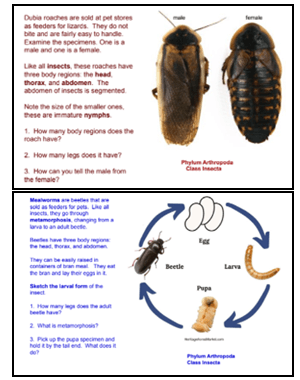
Our curriculum includes a section on invertebrates and vertebrates that usually follows the Evolution unit. This year, I wanted to avoid going into a lot of detail regarding invertebrate taxonomy. Prior lessons would follow the textbook chapters on each phylum: Porifera, Platyhelminthes, Nematoda, Annelida, etc. Students learn the anatomy of each group, a task that could take a long time, especially if you go into detail about each group.
This year, my class periods are shorter, and I really wanted to do more comparative anatomy that showcases each group and not spend so much time on a single one.
I created this station lab for students to get an overview of invertebrate groups. This also gives me a chance to showcase my many (but singular) preserved specimens. Things like tapeworms, crayfish, grasshoppers, starfish, and jellyfish.
This way, students can move around the room and view each. Students are always super fascinated by the jars stored in the cabinet. I must answer a thousand “what’s in the jar?” questions at the beginning of the year!
Activity Set Up
You can set up your own station lab like this with a variety of specimens, some you might just have laying around. I also included some slides of tapeworms, planarian, and hydra. Students are given a handout and asked to sketch each specimen and answer three questions at each station. I made enough for 16, but that can be changed based on class sizes. It took students two class periods to visit all of the stations.
The stations are numbered, so that students can complete the table by matching the number to the station. They do not need to do them in order. In fact, they shouldn’t, because they’d all have to wait for #1 to open.
In past years, I’ve also done labs where students work with live planarian. They have this really unique ability to regenerate. Cut a planarian in half, and it will grow a new head and a new tail. You can order live planarian from Amazon or from biological supply companies. They are fairly easy to keep alive in the short term, just spring water and an aerator are needed.
The Google Slides link goes to a file of the printouts I made for each station. The Doc link is to the student handout. If you make a copy of the Google Slides you can edit them to work with whatever specimens you have laying around in your cabinets!

